Animals of the Arctic. Interesting facts about polar bears
Why don't polar bears eat penguins? After all polar bear it is the largest and most dangerous predator on land, and the penguin is an attractive prey and is not agile on the surface. This question sometimes appears in tests in biology, geography, various quizzes and rating games for schoolchildren.
The largest and most dangerous predator on land is the Polar Bear
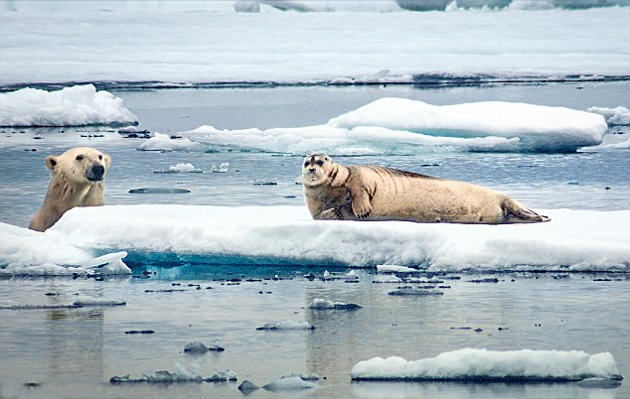
His Majesty the Polar Bear is recognized as the largest land predator. Yes, the weight of an adult male specimen of this representative of the Bear family varies from 400 to 800 kg. If we compare the mass of a bear with a tiger, then the largest representative of the feline (male) gains “only” 275-320 kg, so in the race for the Largest Land Predator, the winner still turns out to be... the Polar Bear.
To gain weight, our animal needs a special diet - protein. Therefore, the polar bear eats fish with pleasure, marine mammals, eggs of careless birds. When meeting a person, he understands that this is 60-100 kg of skin, meat, fat, veins and delicious bones, so he quite consciously hunts every Homo Sapiens that appears in his possessions.
The Polar Bear dives excellently and swims at speeds of up to 6.5 km/h. The animal has developed all types of receptors. He can see a potential victim several kilometers away, smell it 800 meters away, and also hear an animal hiding under the snow or in a hole underground. The white and yellow coloration increases the bear's chances of passing the practical camouflage exam.
Penguins
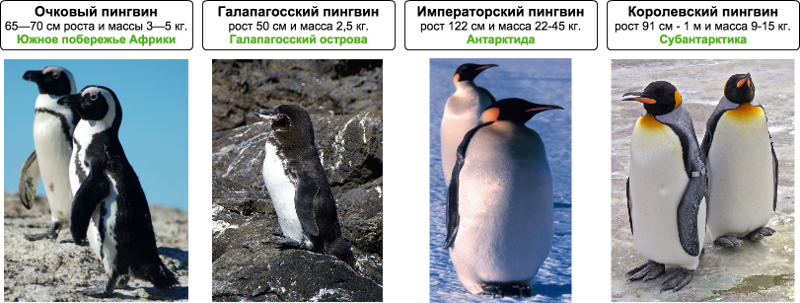
But she dives and swims well. When necessary, it develops speeds of up to 10 km/h in water. On land, birds are more moderate - they move in columns at a speed of 4-6 km/h.
Due to the adaptation of the penguin's eye to diving on land he is nearsighted. Research about auditory receptors is still underway. Therefore, at this stage, only the structure of the outer, middle, and inner ear, which is capable of withstanding increased pressure when diving to depth, has been studied.
The Order Penguinaceae consists of exactly 18 species of birds. The largest representative of the Squad is an adult emperor penguin, capable of gaining weight up to 46 kg. The smallest is small, weighing only 1.25 kg.
Penguins feed on fish and crustaceans. The animals themselves are a favorite food of leopard seals, seals, lions, killer whales and sharks. Brown skuas hunt for chicks. Penguin eggs are stolen by seagulls.
Why don't polar bears eat penguins?
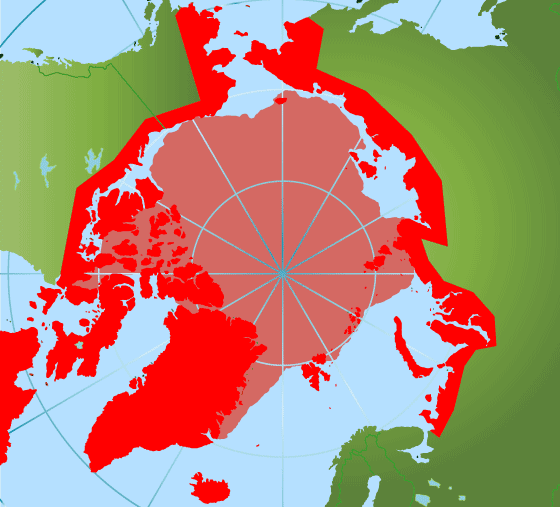
Polar bears don't eat penguins because they live at different poles of the earth! To be more precise - on different continents. - in the north, in the Arctic. This is the waters of the Arctic Ocean and the northern outskirts of Eurasia and North America.

Penguins - in the south, in Antarctica, in southwestern Africa (coastal deserts). Bird remains found in Australia. Therefore, even if they wish, in current realities, polar bears cannot introduce penguins into their diet.
What would happen if polar bears and penguins lived side by side?
Would polar bears eat penguins if they met them in the same territory, water area? Let's think about it. Let's just start over.
Can a polar bear catch a penguin?
If in water, then no, the bird’s swimming speed is one and a half times higher. But on land it’s quite possible, because the bear moves faster. The predator is dexterous, prone to camouflage and intelligent tracking of prey. In addition, the habit of penguins to concentrate in a colony and myopia could well lead to mass killings of birds by bears.
If a polar bear catches a penguin, will it eat it?
The favorite victims of polar bears are walruses, seals, and seals. At the same time, a normal, healthy animal, having killed a walrus weighing 800-1700 kg, eats only the skin and subcutaneous fat. Arctic foxes eat the meat. Naturally, a hungry animal in a bad period will eat the whole carcass, the arctic fox, and the observer. But this is the exception rather than the rule.
Therefore, it is unlikely that a polar bear will like a penguin covered with feathers. And those 2-3 cm of fat that every decent penguin has may be too dubious prey compared to sea hares, seals or walruses.
Polar bear feeding
The main food of polar bears consists of several species of pinnipeds, mainly seals and bearded seals. The ringed seal, or akiba (Phoca hispida), is the most common and numerous seal in the Arctic. Its range to the south extends to the island of Newfoundland, Iceland, the islands of Jan Mayen and Bear, to northern coasts and estuarine parts of rivers of Eastern Europe, Asia, North America, includes the White, Bering and Okhotsk Seas. The seal lives throughout the Central Arctic, right up to the vicinity of the North Pole. It inhabits the areas of the continental slope of the Arctic Ocean with the greatest density. Consequently, the areas of permanent habitat and high numbers of polar bears and seals coincide. For hunters, bears sometimes serve as a kind of indicator of the presence and abundance of seals in a particular area.
The seal feeds mainly on fish, and its distribution is practically independent of the depth of the sea. Adults reach a length of 180-200 cm and a weight of 50-70 kg. These animals lead a relatively sedentary and solitary lifestyle, closely associated with marine, mostly sparse, but not finely broken ice, on which they sleep, molt and give birth to their young. In winter, if there is no open water nearby, seals make their way through young ice“vents” are openings for breathing. In hummocked ice with snow deposits on the surface, seals make wider holes - “holes”, through which they not only breathe, but also climb out onto the ice (into snow shelters) to rest, give birth and feed their young. Ventilations, and especially holes and winter resting places of seals, are invisible from the outside, and bears detect prey in them by smell (maybe by hearing).
Polar bear. Photo: Ltshears
In March-April, the female gives birth to a large calf, reaching 60 cm in length and covered with delicate white fur. The white seal lies in a shelter for three to four weeks, while it feeds on its mother's milk and moults (but if it is disturbed, it, like its mother, goes into the water). In the summer, from May to August, adult seals molt. At this time, they sleep for a long time on the ice, mainly on flat fields of young ice, near leads, gullies or openings, often in groups of several individuals. However, their sleep is very light. Periodically raising their heads, they look around and at the slightest danger they slide into the water.
The bearded seal, or bearded seal (Erignatlius barbahis), reaches 260 cm in length and weighs 200-300 kg. It is widespread in the Arctic seas proper, but is less common than the seal. Like the seal, the bearded seal is closely associated with the ice, on which it rests, molts and reproduces. Unlike it, it lives mainly in shallow waters (feeds mainly on bottom invertebrates) and, possibly, makes seasonal migrations. Just like seals, bearded seals give birth to their young in April-May in snowy shelters built among hummocky ice; in July-August they molt on flat ice fields.
The walrus (Odobaenus rosmarus) is the largest pinniped in the Arctic, reaching a length of over 5 m and a weight of over 1.5 tons. Within their range - in the Arctic and subarctic seas - walruses form several independent herds, one of which lives all year round in the Laptev and East Siberian seas. Animals belonging to other herds make seasonal migrations and migrate to the edge of the ice - to the north for the winter Pacific Ocean or Atlantic. Walruses feed mainly on bottom invertebrates, and therefore are confined mainly to coastal or shallow areas of the seas. They are also closely connected with ice (unconsolidated), on which they form deposits. In the ice (sometimes on land) animals rest, reproduce and molt.
Walrus remains are often found in bear stomachs, but the role of this species in the polar bear's diet is unclear. An adult walrus is apparently too large and has an extremely strong skull, spine and skin to be taken by a predator. In addition, he is able to actively defend himself with the help of his fangs. Young walrus cubs (the body length of newborns does not exceed a meter) are constantly guarded by females and are also inaccessible to bears. Therefore, often on the same ice field one can see peacefully coexisting polar bears and walruses, indifferent to each other.
However, directly opposite information can be found in the literature. So, V.Ya. Parovshchikov writes that in March-April 1960, in the northern and central parts of Franz Josef Land, polar bears fed on walruses, which were successfully caught in fishholes and ice holes. One of the walruses killed by the bear weighed about 400 kg, the second - about a ton. During observations from an airplane along a 600-kilometer route, the scientist counted nine “feeding sites” of bears, and seven contained medium-sized walruses.
Hunters talk about cases of bears attacking even adult walruses. Most likely, polar bears hunt walruses only occasionally, under exceptional circumstances. More often, the remains of walruses killed by St. John's worts, died from wounds or for other reasons are found in their stomachs.
The harp seal (Histriophoca groenlandica) and the hooded seal (Cystophora cristata), also living in the Arctic (the first of them is found from northeastern Canada to the Kara Sea, the second - from Baffin Bay to the western Barents Sea), are similar in their biological characteristics. Both of them make long migrations, their distribution depends little on the depth of the sea (they feed on fish) and lead a gregarious lifestyle. They are less associated with the ice than the seal or bearded seal, but during the birth of young and moulting, they form large haulouts on the ice. Their role in the polar bear’s diet is small. Of the three herds of harp seals, only one is attacked by bears during layover. Sometimes finding itself on ice floes dotted with openly lying and helpless pups, the bear causes great devastation in the haul-out area. Having had his fill, he continues to kill the cubs, according to eyewitnesses, amusing himself like a cat with caught mice. The polar bear preys on hooded seals, especially young ones, mainly in the summer, during their molting.
Depending on the characteristics of the ice and the season of the year, the bear very flexibly changes its seal hunting tactics (although in essence it is based on the use of two or three main techniques). Most often, he conceals prey by approaching it against the wind and using any elevations for cover - hummocks, snow blows, etc. Once on smooth ice, the bear crawls towards the seal, spread-eagled, pressing its head to the ice and even, as eyewitnesses say, covering its nose with its paw for camouflage. A crawling animal pushes off mainly with its hind legs. Each time he freezes at the moment when the seal wakes up and raises its head to look around. Having approached the seal at 4-5 m, the bear jumps up and, having made one or several light jumps, overtakes it, kills it or stuns it with a blow to the head with its front paw and immediately drags it away from the hole or open water. Since the bear’s path to prey among shelters is very tortuous, and on smooth ice it crawls slowly, the hunt can last several hours.
Often the bear watches for prey near openings, vents and cracks. The animal can patiently and motionlessly lie or stand on the ice for hours. He unleashes a lightning-fast blow with his paw on the head of a seal emerging from the water, after which he picks up the victim with his claws and teeth and pulls him away from the water. Before the start of a hunt, the bear sometimes widens the small openings of the vents, breaking the ice with its claws. However, he can pull a killed or stunned seal to the surface through a very narrow hole, breaking its ribs and pelvic bones.
Looking for the snowy resting places of seals, the bear usually walks on the ice with its head low and sniffing. He especially carefully examines the bases of hummocks, icebergs and other places most suitable for seal shelters. Having discovered a resting place, the animal with a blow of its paw (or both barks) collapses the snowy arch, and pieces of crumbling snow often plug the hole under the water. Quickly shoveling the snow, he gets to the white or adult seal and kills it.
A bear sometimes approaches seals lying on the ice from the water and swims silently, diving deep under the water (according to stories, it even pushes a small ice floe in front of itself for camouflage). Once at the edge of the ice, he jumps onto it in one jump and cuts off the victim’s escape route. Sometimes you can see a bear lying on the edge of an ice floe and trying to grab a surfaced seal with its paws. Occasionally, he even tries to chase seals in the water, but the success of such a hunt is doubtful.
Of course, not every bear hunt brings him prey. Seals lying on smooth ice, suspecting danger, often manage to go into the water long before the predator approaches. To breathe in the winter months, seals often use many vents, and sometimes a long wait for a bear at one of the vents may be useless. Finally, even a blow with a paw does not guarantee the bear complete success, since he does not always manage to keep large prey above the water or on the ice. Evidence of this can be, for example, numerous scars and scratches from bear claws on the skins (especially often on the back of the body) of sea hares hunted by hunters in the Barents and Kara Seas.
If the animal is hungry and the prey is small, the bear eats the entire seal (primarily the subcutaneous fat with skin, sometimes also the entrails). A well-fed bear is content with only fat, eats the rest of the carcass after sleep (he sleeps near the hunting site), and sometimes leaves it uneaten. In some cases, the bear stores food by burying the remains of the seal in the snow.
If necessary, the polar bear preys on any animals available to it, including in rare cases large terrestrial animals such as reindeer (Rangifer tarandus) or musk ox (Ovibos moschatus). When they find themselves on islands where there is no opportunity to hunt seals, for example in Iceland, the animals sometimes attack livestock: sheep, horses, cows. Once on land, the bear willingly feeds on lemmings (Lemmini), catching them on the surface of the earth or digging them out of holes, eats bird eggs, and on occasion eats brood hens, chases and preys on geese (Anser). Polar bears can be seen especially often on Arctic islands near bird colonies, where the animal picks up dead birds, chicks that have fallen from cliffs (guillemots (Uria), guillemots (Cepphus), gulls (Larus)), and often gets to the nests themselves.
It happens that bears eat arctic foxes (Alopex lagopus) caught in traps and mouths, eat baits and bait in traps, and at the same time spoil the traps (the traps are often carried away along with the prey), thereby harming the arctic fox fishery. Animals also willingly eat fish, but cannot catch it themselves (they only catch salmon (Salmonidae) fish that enter small rivers to spawn).
Of no small importance in the diet of polar bears are carrion - the carcasses of dead pinnipeds (Pinnipedia), cetaceans (Cetacea), marine invertebrates thrown out by the sea - and garbage at hunting sites, near ships drifting in the ice, human settlements, etc. Sometimes bears rob warehouses, non-residential buildings, storehouses, eating any food they find, even flour and cereals, but they are especially willing to eat meat, fish and sweets. Among polar bears, as already mentioned, cannibalism is quite common. This is evidenced by the stories of hunters and literary data. Large bears attack small and weak ones (they readily eat the carcasses of killed animals of their own species).
Polar bears also eat various plant foods. They consume these feeds when they find themselves on land, usually in the summer. Direct observations and as a result of analysis of stomach contents have established that polar bears eat seaweed (Lami-naria, Desmarestia), blueberries and crowberries (the animals eat them especially willingly), stems and twigs of willows (Salix arctica), various cereals, mosses and lichens. Sometimes inedible objects are found in the stomachs of hunted animals: scraps of cloth, rope, rubber, wood chips, etc.
According to scientists, bear cubs aged about 6 months eat no more than 2.5 kg of food at one time, but adult animals eat 6-7 kg, and sometimes more. The maximum amount of food eaten by a polar bear at once is 25 kg. The results of a study of bear stomachs are consistent with these data. They found up to 8-9 kg of seal fat. 25 kg of walrus fat was found in the stomach of the hunted bear. V.Y. Tsalkin even found 71 kg of walrus fat in the bear’s stomach.
Approximately per year, a polar bear hunts and eats about 50 seals.
Geographical changes in polar bear nutrition are generally insignificant. In addition to seals and bearded seals, which form the basis of its diet, in the north Atlantic it sometimes hunts and eats harp seals and hooded seals. Walruses are important in its diet only in places where walrus fishing is widespread (mainly in west coast Greenland and the Bering Strait). Bears eat berries only in relatively southern parts its range (on the coasts of Hudson Bay, the Chukotka Peninsula). In areas of intensive spawning fish migration (for example, salmon) off the coast of Labrador, a significant part of the polar bear’s diet is fish. Some differences in diet in summer are found among polar bears living on the mainland coasts and islands of the south of Hudson Bay and James Bay. "Mainland" bears are much more more They eat terrestrial plant food and seaweed. “Island” bears eat birds in greater numbers.
Seasonal changes in the diet of animals are more pronounced. In the spring (March-April), with the beginning of seal breeding, polar bears specialize mainly in catching seal whites and at this time are better provided with food. From the end of April to the end of May - the beginning of the mass occurrence of seals on the ice and their molting - these animals, obviously, are less well provided with food (as evidenced by cases of males hunting bear cubs).
In summer (June-July) bears do not suffer a shortage of food, since at this time molting adult seals are found everywhere. Individuals forced to spend the summer on land find themselves in a worse situation and, as already noted, switch to consuming plant foods.
In autumn (August - October), the opportunities for bears to obtain food seem to be somewhat reduced. However, the animals do not experience great difficulties because August is the height of the molting of sea hares, and young seals at this time are still inexperienced and careless.
In winter, especially during its first half (November-December), when seals stay mainly under thin young ice, and seals migrate to areas of open water, the hungriest season begins for bears. Some animals (not only pregnant bears, but also males and barren females) in the high latitudes of the Arctic and generally in areas poor in food spend this time lying in dens. However, many individuals continue to stay awake and obtain food with great difficulty. At the beginning of winter, the path a bear makes from one hunted seal to another can be hundreds of kilometers, and often the animals remain without food for 8-10 or more days. Evidence of long-term hunger strikes of animals is the fact that in November-December they behave more boldly when meeting people and at this time they pose the greatest danger to humans.
In the second half of winter (January-February), when seals stay among the hardened ice and more often rest on the ice, using snow shelters, bears hunt more successfully, and their feeding capabilities begin to improve.
Many of us believe that polar bears have white fur, but in reality this is not so: the animals’ hair, like the undercoat, is transparent and completely colorless. And they appear white to us because there is an air pocket inside each guard hair. When a light beam consisting of all , hits the wool, the colors from the air pockets are reflected and, mixing, give a white color.
Depending on the season and the location of the Sun, the animal’s fur can be not only white, but yellow or brown (bears living in captivity can even be green due to algae in artificial reservoirs). But if someone managed to shave off all the fur from an animal, they would be surprised to discover that the skin of a polar bear is black. The dark skin helps absorb and retain the sun's rays, protecting the predator from the Arctic frosts.
The polar or polar bear is the largest predatory mammal that lives on the surface of the earth (second only to the elephant seal). He is the closest relative of the brown bear and belongs to the bear family. In nature, there are about fifteen species of polar bear, and the total number of animals is about twenty-five thousand.
You can meet these animals in subpolar latitudes northern hemisphere starting from Newfinland and ending at 88° N. sh., and they live on ice floating in the Arctic off the coast of Eurasia and America, so they can only be classified as terrestrial inhabitants only conditionally.
If you think about what natural area polar bears live, you might be surprised: they are the only large predators Arctic, ideally adapted for normal existence in polar latitudes. For example, during snow storms they dig holes in the snowdrifts, lie down in them and, without going anywhere, wait out the elements.
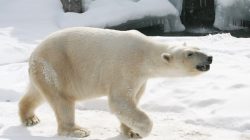
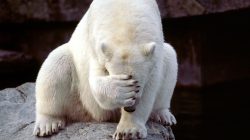
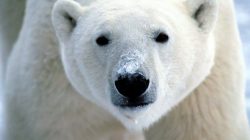
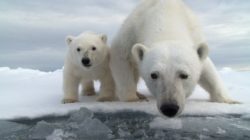
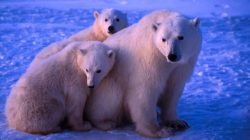
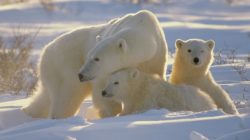
The size and weight of these animals largely depend on their place of residence: the smallest animals according to description live on Spitsbergen, while the largest ones live in the Bering Sea. Average height A bear at the withers reaches about one and a half meters, while the weight of males significantly exceeds the weight of females:
- The weight of males ranges from 400 to 680 kg, length - about three meters (the mass of large lions and tigers does not exceed 400 kg);
- The weight of females ranges from 200 to 270 kg, the length is about two meters.
According to the description, the polar bear differs from other representatives of its species by its greater weight, powerful sloping shoulders, flat head and longer neck.
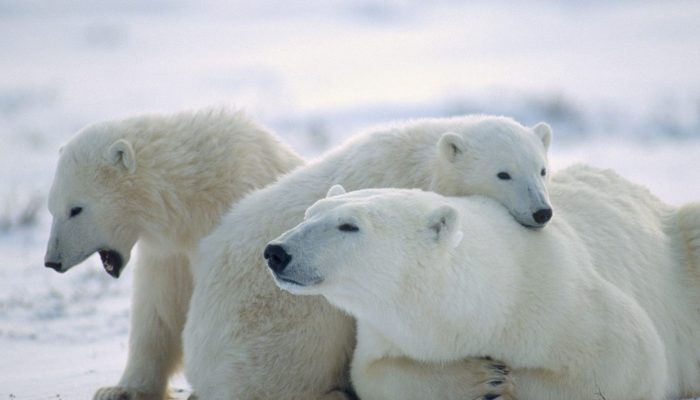
There is fur on the soles of the paws, which allows the animal not to slip and freeze. There is a membrane between the toes, and the structure of the paws allows polar bears to swim gracefully, gracefully and quickly. Large curved claws are not only capable of holding even strong prey, but also allow it to easily move on slippery ice and climb over blocks.
It is noteworthy that these animals are quite capable of reaching speeds of up to 10 km/h and swimming about 160 km without stopping. They are also very good divers and can stay underwater for about two minutes.
The polar bear does not freeze thanks to a thick, about 10 cm, layer of subcutaneous fat on the back, back of the body and hips, as well as very warm fur, which retains the heat generated. The predator's fur is very thick and dense; it not only reliably retains heat, but also protects the animal's body from getting wet, and its white color makes it possible to camouflage perfectly.

The teeth of polar bears are also noteworthy: in cross-section, they form annual circles of two cement layers. The tooth is tightly attached to the jaw, as the root of the teeth is connected to it by a layer of cement that grows throughout the bear's life. IN different time Each year, the layer grows differently and seems to consist of two parts: the winter layer is thinner than the summer layer, which is located above it, and the older the animal, the smaller the distance between the rings.
Way of life
Although polar bears give the impression of being a clumsy animal, in fact they are very fast, agile, and excellent at diving and swimming, both on land and in water. For example, when escaping danger, a polar bear can move at a speed of about 7 km/h without any problems. They are capable of covering considerable distances: the record for the longest movement was recorded for a polar bear, who, together with her baby, swam 685 km across the sea from Alaska to the north in search of a new home.
The main reason why she did this was that the place where the polar bears lived was no longer suitable due to the melting of the ice floes: the seals left their place of residence. Unfortunately, the cub died during such a nine-day swim, and her weight decreased by twenty percent.
Despite their ability to develop high speeds, polar bears still prefer to move slowly and without haste: although temperatures in the Arctic can drop to minus forty, these predators usually experience problems not with freezing, but with overheating (especially when running).
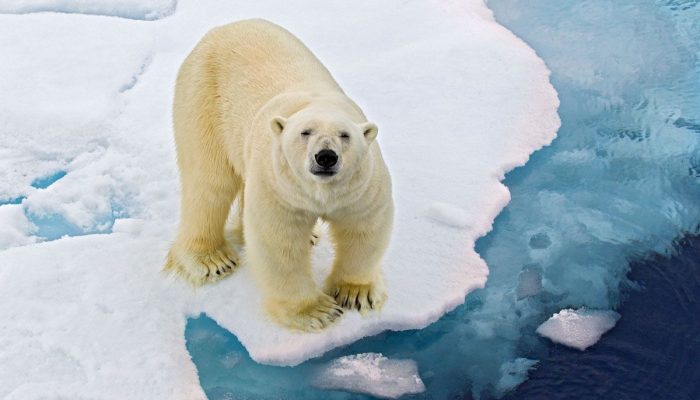
Despite the fact that polar bears are solitary animals, they do not fight for their territory and have a positive attitude towards other representatives of their species: they often colonize an area in groups and roam with each other. In the absence of food, they are able to eat their relatives.
Animals also do not live in one place for a long time and move along with the ice, which floats closer to the pole in the summer, and to the south in the winter, while once near the continent, the predator comes to land. The polar bear prefers to be either on the coast or on glaciers, and in winter it can easily set up a den for itself at a distance of 50 km from the sea.
It is worth noting that the female sleeps the longest during pregnancy (two to three months), while males and non-pregnant female bears hibernate for a short period, and not every year. When they go to bed, they always cover their nose with their paw: this helps them conserve heat.
When they talk about where polar bears live, ice floes immediately come to mind - it is there that these predators are able to find food for themselves: seals, ringed seals, walruses, bearded seals, and other sea animals that are part of the predator’s diet live here. During the year, he travels about one and a half thousand kilometers in search of food. Thanks to the huge reserves of subcutaneous fat, it is able to go without food for quite a long time, but if the hunt is successful, it can easily eat up to 25 kg of meat at a time (usually a bear catches a seal once every three to four days).

Thanks to its white color, excellent hearing, perfect vision and excellent sense of smell, the bear is able to smell its prey several kilometers away (a seal at a distance of 32 km). It catches prey, sneaking up from behind shelters, or watches for it near holes: as soon as the prey sticks its head out of the water, it stuns it with its paw and pulls it out. But for some reason, polar bears hunt on the shore very rarely.
Sometimes, when he swims up to an ice floe where seals are resting, he capsizes it and catches prey in the water (it is these animals that mainly make up his diet). But a polar bear can only cope with a heavier and stronger walrus. solid ground where he becomes clumsy.
It is interesting that the polar bear does not eat its entire prey, but only the fat and skin, everything else only if it is very hungry (polar foxes, arctic foxes, and seagulls eat the carcass after it). If there is no usual food, the polar bear feeds on carrion and does not hesitate to eat dead fish, eggs, chicks and even algae. After a meal, a polar bear spends at least twenty minutes cleaning itself, otherwise the wool will reduce its thermal insulation properties.
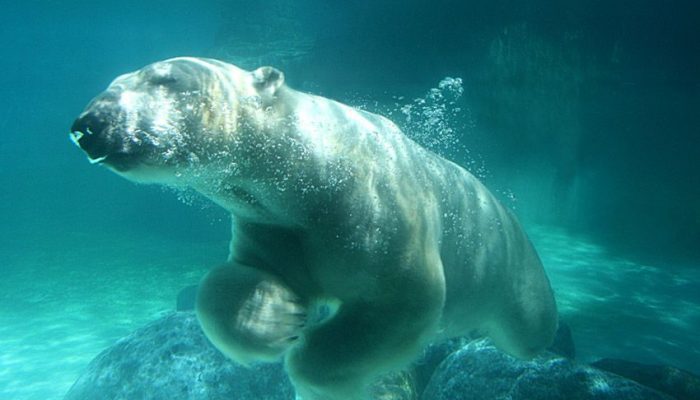
Thanks to this method of feeding, the polar predator receives a sufficient amount of vitamin A from its prey, which is deposited in its liver in such quantities that more than one case of liver poisoning of this animal has been recorded.
Polar bear camouflage
Polar bears are capable of perfect camouflage, and they are able to become invisible not only to their prey, but even to the infrared cameras with which scientists monitor predators. This was discovered by zoologists during a flight over the Arctic, which was made with the aim of counting the population of these animals. The equipment failed to notice the bears, since they completely merged with the surrounding ice. Even infrared cameras could not detect them: only eyes, black noses and breathing were reflected.
Bears have become invisible due to the fact that with the help of infrared cameras it is possible to see not only temperature indicators of the surface, but also the radiation that comes from the observed objects. In the case of polar bears, it turned out that their fur had radio-emitting properties similar to those of snow, which is why cameras were unable to record the animals.
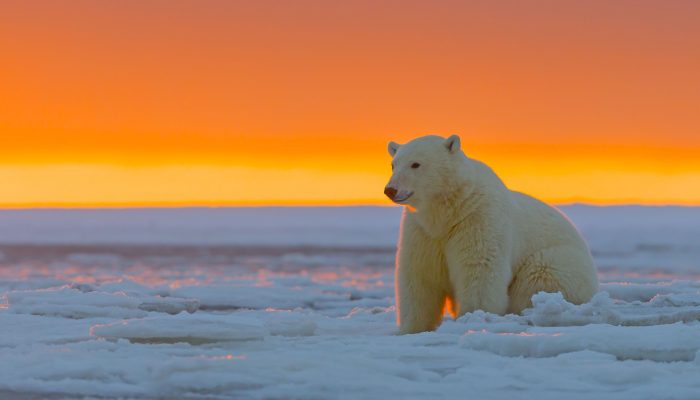
Offspring
The she-bear gives birth to her offspring for the first time no earlier than four years(and sometimes the first birth occurs at eight). She gives birth to no more than three cubs every two to three years. The mating season usually lasts from March to June, with one female followed by about three to four males, who constantly fight with each other, and adults can even attack and kill cubs. Polar bears can interbreed with brown bears, resulting in offspring that, unlike many other animal species, are also capable of reproducing.
The female bears prepare to give birth in October, starting to dig dens near the coast in the snow drifts. To do this, females often gather in one place; for example, about two hundred dens appear annually on Wrangel Island. They do not settle in them immediately, but in mid-November, and hibernate until April. Pregnancy lasts up to 250 days and the cubs appear blind and deaf, usually in the middle or end of the Arctic winter (their eyes open after a month).
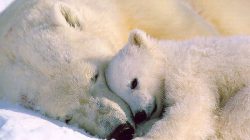
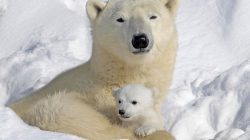
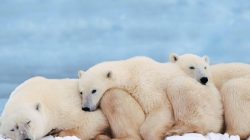
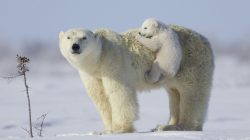
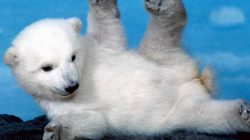
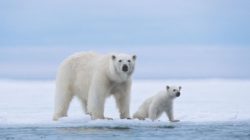
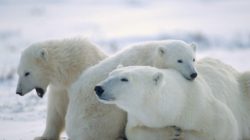
Despite the impressive size of an adult, newly born babies are not much longer than a rat, and their weight ranges from 450 to 750 grams. When the cubs are about three months old and gain weight, they begin to gradually leave the den with the mother bear, gradually switching to a wandering lifestyle. The cubs live with their mother for three years, and until they are one and a half years old, she feeds them with milk, while at the same time feeding them seal blubber. The mortality rate among babies is quite high and ranges from 10 to 30%.
Animal life in the modern world
Polar bears are listed in the IUCN Red List: despite the fact that their numbers are considered stable and even growing, the slow reproduction of white predators, poaching (about 200 animals are killed annually) and high mortality among cubs make the population easily vulnerable, and in some places they have disappeared at all.
Recently, a sharp decrease in population has been recorded in Russia: animals living in the region of Yakutia and Chukotka have completely disappeared in some areas. The lifespan of these predators in nature is about 25 years, while in captivity they can live up to forty-five.

In addition to poachers, the lives of polar bears are affected by global warming: over the last century, air temperatures in the Arctic have risen by five degrees Celsius, which is why the area of glaciers on which these animals actually live is constantly shrinking. This directly affects the population of seals, which are their main food, allowing them to accumulate the necessary fat reserves.
During melting, the ice becomes unstable, as a result of which the bears are forced to go to the coast, where there is not enough food for them, and they significantly lose weight, which negatively affects future cubs.
Another important problem is oil, which is present in considerable quantities in the sea water around drilling rigs. While thick fur protects bears from dampness and cold, if it becomes stained with oil, it loses its ability to retain air, causing the insulating effect to disappear.
As a result, the animal cools down faster, and the black skin of the polar bear runs the risk of overheating. If a predator also drinks such water or simply licks it off the fur, this will lead to kidney damage and other diseases of the gastrointestinal tract.
The polar (or polar) bear is a predatory mammal belonging to the Bear family. Ursus maritimus is its Latin name. Where does a polar bear live and what does it eat? How does it reproduce and interact with other animals? What is its population? Where does the animal live? More on this later in the article.
Origin
It was initially assumed that the separation of the brown and polar bear happened about 45-150 thousand years ago, possibly in the territory occupied by modern Ireland. But recent research has revealed that the division occurred about 338-934 thousand years ago. About one hundred to two hundred years ago, representatives of species crossed, which resulted in hybridization. As a result, all polar bears inhabiting the planet today are descendants of the resulting hybrids.
External data
The polar bear is considered one of the largest representatives of terrestrial mammals from the order of predators. The height of individuals can reach 3 m, weight - up to a ton. The most common are males, whose weight is from 400 to 450 kg, and their body length is up to 250 cm. At the withers, the height is from 130 to 150 centimeters. Females weigh significantly less - from 200 to 300 kg. The smallest representatives live on Spitsbergen, and the largest ones live in the water area Bering Sea. The white bear is distinguished from other bears by its flat head and long neck. 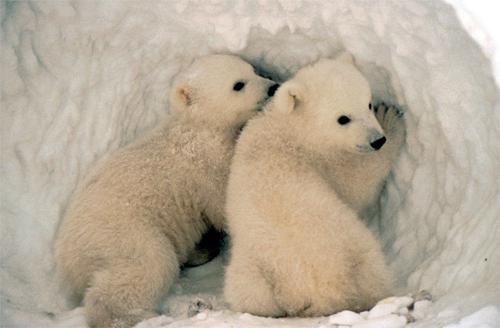 Skin color - black. The fur can range in color from yellowish to white (in summer the “fur coat” may turn yellow due to constant exposure to direct sunlight). The fur is hollow, and the fur itself is devoid of pigment. Translucent hairs are capable of transmitting, due to which the cover acquires thermal insulation properties. When carrying out UV photography, a polar bear may appear dark, and sometimes it may even turn green. This usually happens if a white bear is in a zoo, in a hot climate. Due to the special structure of the hairs, microscopic algae grow in them - hence the green color of the skin. In order not to freeze and not slide on the ice, the soles of all limbs are lined with wool. There is a swimming membrane between the toes, and hard bristles are present on the front of the paws. Further in the article we will learn more about what polar bears eat.
Skin color - black. The fur can range in color from yellowish to white (in summer the “fur coat” may turn yellow due to constant exposure to direct sunlight). The fur is hollow, and the fur itself is devoid of pigment. Translucent hairs are capable of transmitting, due to which the cover acquires thermal insulation properties. When carrying out UV photography, a polar bear may appear dark, and sometimes it may even turn green. This usually happens if a white bear is in a zoo, in a hot climate. Due to the special structure of the hairs, microscopic algae grow in them - hence the green color of the skin. In order not to freeze and not slide on the ice, the soles of all limbs are lined with wool. There is a swimming membrane between the toes, and hard bristles are present on the front of the paws. Further in the article we will learn more about what polar bears eat.
Life
Polar bears live on fast ice and drifting ice. There they hunt and get their main food. What do polar bears eat? Their main food is ringed seal, walrus and others. They catch their prey by sneaking from behind cover or near holes. As soon as the victim removes its head from the water, the animal stuns it with a blow from its paw and drags it ashore. A polar bear can also knock over an ice floe on which seals are sitting. Walrus hunting is carried out only on land. As a rule, it eats lard and skin. In case of severe hunger, it devours the entire walrus carcass. But usually the remains of the caught animal are then eaten by arctic foxes. But that's not all that polar bears eat. On occasion, they can also pick up carrion, dead chicks, fish, and eggs. Their diet also includes grass. If polar bears appear in human-inhabited areas, they can be seen in garbage dumps, not far from household and food waste dumps. 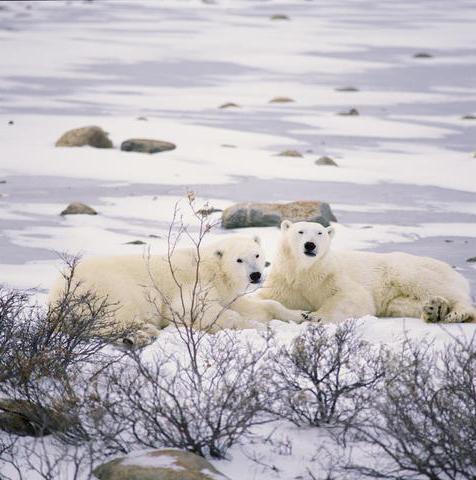 There are even known cases of them robbing food warehouses of polar expeditions. Everything that polar bears eat contributes to the accumulation of vitamin A in their liver. This compound is contained in their body in fairly large quantities. There are even reports of several cases of liver poisoning. Does a polar bear eat penguins? This question may arise from those who are new to the habitat of these animals. It is known that penguins inhabit the South Pole, and polar bears inhabit the North Pole. There is no way they can meet under natural conditions. It was described above what polar bears eat. And representatives of the South Pole are not included in their diet.
There are even known cases of them robbing food warehouses of polar expeditions. Everything that polar bears eat contributes to the accumulation of vitamin A in their liver. This compound is contained in their body in fairly large quantities. There are even reports of several cases of liver poisoning. Does a polar bear eat penguins? This question may arise from those who are new to the habitat of these animals. It is known that penguins inhabit the South Pole, and polar bears inhabit the North Pole. There is no way they can meet under natural conditions. It was described above what polar bears eat. And representatives of the South Pole are not included in their diet. 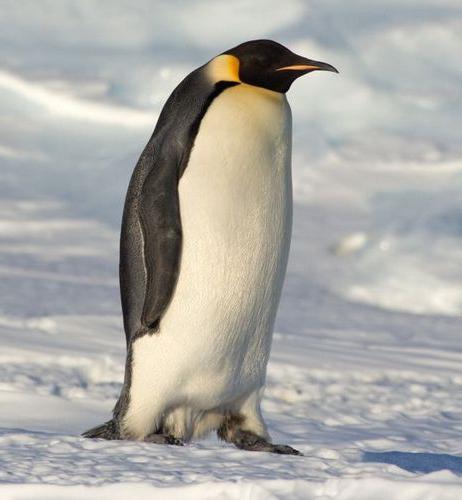
Nomads
In accordance with the annual change in the boundaries of polar ice, polar bears make seasonal transitions. In the summer they retreat closer to the pole, in the winter they migrate to southern territories, entering the mainland. Despite the fact that polar bears mainly stay on ice and coasts, they can lie down in dens on islands or on the mainland, in some cases fifty kilometers from the sea. Winter hibernation, the duration of which varies from 50 to 80 days, is usually characteristic of pregnant females. Single females and males do not mate annually and for a fairly short period.
Behavior
Despite their apparent slowness at first glance, bears are fast and agile even on land. In water they dive and swim quite easily. The bear's body is protected from getting wet and cold in the water by dense and very thick hair. A special adaptive task is performed by subcutaneous fat with a layer of up to ten centimeters. The camouflage of a predatory animal is greatly facilitated by its light coloring. Polar bears have very well developed hearing, vision and sense of smell. They can see their prey from several kilometers away, and, for example, they can smell a seal from 800 meters away. 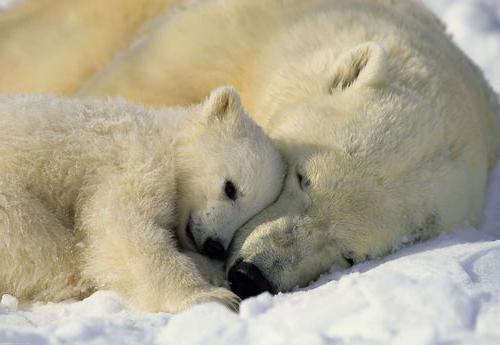
Reproduction
The rut for polar bears begins in March and ends in June. In estrus, a female is usually followed by three or four males. By October, females begin to dig dens in the sediment. Bears have favorite territories where they gather (Wrangel Island, for example). Every year there are about 150-200 burrows in such places. Mother bears settle in dens only by mid-November, after the latent stage of bearing cubs has ended. The entire pregnancy lasts 230-250 days. At the end or in the middle of the Arctic winter, cubs are born. The female herself remains in hibernation until April. It should be said that female bears have a low reproductive potential. The first offspring appears at 4-8 years. Childbirth occurs every two to three years, with one to three cubs in one litter. As a result, a female brings no more than ten to fifteen cubs in her entire life. Newborns weigh from 450 to 750 grams. After three months, the female leaves the den with them and begins a wandering life. The cubs remain with their mother for up to one and a half years. During this entire period, she feeds the cubs with milk. 
Social structure
It should be said that mortality among cubs reaches 10-30%. The life expectancy of bears is no more than 25-30 years, the record for longevity in captivity is forty-five years. As a rule, animals are peaceful relative to members of their own species. But during the mating season, clashes between males can occur. Sometimes adult males attack cubs, mostly males. Polar bears can interbreed with brown bears. As a result, fertile (reproductive) offspring appear - polar grizzlies.
Population status and economic importance
The polar bear is listed in the Red Book of the Russian Federation as rare view. Due to the high mortality rate of young animals and slow reproduction, this animal becomes quite easily vulnerable. But even despite this, today it is considered relatively stable, even growing in some way. Eskimos hunt polar bears for meat and skins. In Russia, hunting of animals has been prohibited since 1956. In other countries (Greenland, Canada and the USA), polar bear hunting is limited. On the territory of Russia today there are about 5-7 thousand individuals. At the same time, poachers shoot about 150-200 bears per year.
Here you can read about the birds and animals of the Arctic, look at their photographs, and find out our impressions of meeting them in real conditions. I will talk about polar and (oddly enough) brown bears, walruses, arctic foxes, seals, deer, foxes, hares, ducks, geese, terns and many others.
The Arctic is home to a huge number of different animals and birds. Of course, the most important ones are polar bears. We met bears twice. Both times there were no casualties or incidents. True, it took a lot of nerves :)
Polar bears are the most famous animals of the Arctic
There are many different names for a bear: white, polar, northern, sea... Once upon a time, the white and brown bear had one common ancestor. But, about 600 thousand years ago they separated. It is believed that until recently, the habitats of polar and brown bears did not overlap. However, their rapprochement is already underway.
I am not a scientist, the reasons for this rapprochement are not known to me - maybe it’s the melting ice, maybe it’s because polar bears have recently multiplied a lot and are forced to explore new territories in search of food, maybe for some other reason, however, in one territory There may be both brown and polar bears. If they meet each other, what will it be like? further development events?
Personally, we had the opportunity to meet both polar and brown bears in almost the same place. So far they don’t seem to intersect, but it feels like it won’t be for long. For example, if polar bears reach Varandey, and we met brown bears on the Korotaikha River, not far from the sea, then it turns out that in the territory between Varandey and Karatayka, brown and polar bears can cross paths, and this is literally a hundred kilometers, which is not for them distance. Most likely, they will simply disperse. But either way it would be very exciting to watch.
You can read more about the polar bear on Wikipedia, however, I want to warn you that even there the information may not be entirely correct. For example, according to the encyclopedia, polar bear lives on drifting and fast ice sea ice, where it hunts its main prey: ringed seal, bearded seal, walrus and other Arctic marine animals.
However, I would say that the bear mainly lives on sea ice. In fact, a bear can very easily live on the coast of the Barents Sea and on nearby islands, where there is no smell of ice in the summer. In summer, flowers, mushrooms, berries grow there and a huge number of different animals and birds live there. So it would be a huge misconception to think that polar bears live only on ice.
Again, Wikipedia says that the polar bear “makes seasonal migrations in accordance with annual changes in the polar ice boundary: in the summer it retreats with them closer to the pole, in the winter it moves south, entering the mainland. Although the polar bear stays mainly on the coast and ice, in winter it can lie in a den on the mainland or on islands, sometimes 50 km from the sea.”
In fact, polar bears can be found on the mainland in the summer. Actually, that’s what happened to us. We were not prepared for this, thinking that bears are here only in winter, and even then rarely. As you can see, we were wrong.
While we live in a civilized city, bears seem like nice white fluffy creatures that are very nice to look at and that need to be protected from the evil Chukchi and Nenets. When you find yourself in the north, when you meet bears, they turn out to be terrible monsters that are almost impossible to get rid of. When you look at it, it seems that such a colossus is completely impossible to kill with one rifle bullet, and this makes it especially unpleasant. After all, these are the largest land predators that have no natural enemies. They are not afraid of anyone and behave accordingly.
But what are bears really like? Maybe these are not fluffies, and not aggressive evil predators? Maybe they have nothing in common with our ideas about them?
For example, when we were traveling in the Kara Sea and unexpectedly met a bear, we experienced a real shock. We can say that from the moment we met the bear, the underlying fear did not leave us for a minute. Our comrade, who visited Novaya Zemlya this year, said the same thing. Having met the polar bear, his comrades could no longer calm down: they saw the bear in every snowdrift, on every ice floe, throughout the entire journey.
Needless to say, neither they nor we parted with our weapons after that, and even went out together when needed, with a loaded gun. In general, the feeling of a weapon constantly hanging on a shoulder or lying along a sleeping bag almost instantly became so familiar to us that the rare moments of safety, when the gun could simply be unloaded and put aside, seemed something unusual and very pleasant.
Arriving in Amderma and talking with local residents, we heard a lot of horror stories about bears and encounters with them. Before we had time to land on the shore, divers clearing the approach to the port said that just yesterday a polar bear had walked here, in this very place. Having scared the workers, he wandered among the containers and equipment, and then, having admired the frightened people to his heart’s content, jumped into the water and swam away. By the way, he jumped almost to the very place where the diver was working at that moment (he, apparently, having seen the animal that came to the port, chose to stay under water).
BUT! Do you know what's most interesting? A woman who has lived in Amderma since birth and happily entertained us with amazing bear stories, recalled only one case of a person dying from the paws and teeth of a polar bear. This happened in terry Soviet times, when 15,000 people lived in Amderma and among them a large number of children. The children were taken to school by bus, but a couple of children fell behind the bus and walked home. That's when the bear met them.
Apart from this story, the Amdermian woman did not remember anything terrible. Yes, she talked about numerous encounters with predators, about how they sat a few meters from people, how they walked around the city and even licked the heels of some local fisherman who had fallen asleep in a ravine. But all these stories ended quite peacefully, and not a single person was hurt.
Yes, this, of course, does not prove anything and does not mean that bears are safe. However, having already returned home, we met with one of the Amderma divers and once again heard from him a story about bears and the carcass of a dead walrus that had been lying on the beach near the airport for several days (literally everyone told us about this back in Amderma).
The fragrant corpse, of course, like a magnet, attracted polar bears that came here from the leeward side of the coast. While one of the bears was eating, local residents, instead of hiding in horror in the airport building, went ashore and took pictures with the predator in the background. From the photo you can see how close they were.
Or, for example, there is one photographer in Amderma: judging by his photographs, he follows the unfortunate fluffies every time, in general, on their heels - he just doesn’t get on their heads. And nothing, he’s still alive.
Well and what is it? What does it mean? Stupid recklessness? Or something that we don’t know, but the locals know? Maybe the bear, in fact, is not as dangerous as we see it? Maybe he's just acting too self-confident, and that's why he scares us so much? We are accustomed to the fact that any animal, be it a wild deer or a brown bear, prefers to hide from us as quickly as possible, while the polar bear simply stands and watches with curiosity as a man shoots into the air and swears at the shit in front of him. Apparently, fear has big eyes.
Brown bears
Yes, brown ones are also found in the Arctic. We met brown bears only once. And even that can be considered lucky, since they are cautious and avoid people.
The Latin word for brown bear is Ursus arctos. It would seem that there is a direct reference to the Arctic :) Moreover, brown bears really live there.
However, the Internet often disagrees with this. In the public consciousness, only the white (polar bear) and period are associated with the Arctic. For example, this seems unfair to me. It’s even a shame for the poor brown bear.
It even gets to the point of being funny. For example, there is such a game: “Bear Bound” - “Brown Bear in the Arctic”.
Game description: By the will of fate or in some incredible way, this happened, and our brown bear ended up in the north. His body, and he himself, are not accustomed to such bitter frosts. Therefore, during a storm, which is warned about by a special signal, he has to seek shelter and climb into the walruses’ houses. Moreover, you must be wary of meeting scouts, the ski devil, or people who are not averse to making fun of the bear, eating it, or launching it into space.
Those. the creators of the game do not even assume that there is nothing extraordinary here and brown bears really live in the north and can really meet with walruses. Yes, we saw walruses and brown bears in almost the same place, on the mainland, by the sea. Those. theoretically, they may well intersect. And practically, perhaps, too.
Fortunately, you can still find nuggets of information on the Internet about brown bears in the Arctic:
In summer, especially when there is an abundance of mouse-like rodents and berries, it is often found in the continental tundra. It feeds on a variety of animal and plant foods, the composition of which varies depending on the area and season. Among plants, it eats stems, leaves, rhizomes of various herbaceous plants, tree leaves, berries and wild fruits. Animals: fish, insects and their larvae, small rodents, carrion. Sometimes, especially in spring and autumn, it attacks large animals (elk, deer).
It just so happened that the wind was blowing in our direction and the bears did not smell us. And their vision is not good enough for them to see us. So we can say that we were lucky with this meeting. Otherwise, the animals simply passed us by, and we would not even have guessed that a mother bear with two cubs was passing by.
It all happened like this: having landed on the shore in the evening, we set up a tent and prepared to make a fire. While Petya kept the fire going, I looked around and suddenly noticed some movement. My eyesight is poor, so I didn’t understand who was walking there. Then I called out to Petka and asked to see who it was. Petka took a closer look and at the first moment decided that these were dogs, but then it dawned on him that they were a mother bear with cubs. We knew that bears most often prefer to avoid contact and avoid people, but a mother bear is capable of anything to protect her cubs.
The bears had not yet noticed us, but were wandering around the tundra, turning over stones and looking for ants. We began to fuss, afraid that they might approach our tent. And then - who knows what comes into their heads.
Petka grabbed the gun and stood ready. At first he loaded the buckshot, but then, after thinking about it, he threw away the buckshot cartridge and loaded the shot, so that, if anything happened, he would first shoot into the air and thereby scare away the animals. And I, in the absence of binoculars, looked into the camera, observed the direction of movement of the bears and photographed them along the way.
Apparently at that moment we were talking quite loudly, rushing from the tent to the fire and waving our arms, so the bear noticed us and immediately took off running. Having moved a decent distance away, she stood up to her full height and began to examine us. Realizing that there were people nearby, she, without hesitation, ran into the tundra. The cubs, naturally, followed her, not lagging behind even a step.
Realizing that the bears had left, we went to dinner, but, nevertheless, the rest of the night we slept rather restlessly. Still, this was our first meeting with bears.
And bears, of course, are beautiful. Despite the fact that they are called “clubfooted”, they run very quickly, smoothly and gracefully.
Deer
Deer are cute. Very beautiful and useful animals. They have such cool, fluffy antlers. It feels like they are as soft as a kitten's skin. And they are also pleasant to touch.
We have met deer on every trip we have taken to the Arctic over the past 4-5 years. For example, here is the first meeting on the Terek coast of the White Sea, which especially amazed us. Then this thing became more common.
Reindeer herds range from several hundred to several thousand heads. For example, a reindeer herder I met in the Bolshezemelskaya tundra said that there were about 2,000 individuals in his herd. And the Nenets met on Kanin claimed that they had about 5,000 animals.
This is what the deer management process looks like:
“A minute ago, the deer were grazing on the sandy littoral, but now it’s time to drive them further. The shepherd foreman, walking on half-bent legs (his fingers seemed to be frostbitten, so he walked with great difficulty), went out to the beach, stood not far from the herd, looked at the deer and suddenly began to make special passes with his hands and shout out special sounds.
“Hooo, Heey, Heyhooo,” he shouted in a hoarse, rough voice for a couple of minutes and suddenly the deer began to move and slowly flowed in the right direction, gradually moving to a gallop.
One of the brigade workers, dashingly crossing a shallow channel on his sleigh, went to correct the movement of the animals. Literally a few minutes later, the beach was empty, and only a deer that had strayed from the herd timidly ran past us and disappeared into the tundra.”
For an unprepared person, this looks like real witchcraft - well, how can one reindeer herder control thousands of reindeer? It's mind boggling. Meanwhile, they do this every single day. I think the secret is that they have been engaged in reindeer husbandry almost from the cradle, they know every deer “by sight” (to be honest - they remember each of their 5,000 deer), and they have studied the tundra like their own fingers (I won’t say that everyone has five pieces - sometimes there are fewer, because they really “love” to freeze their limbs).
Why does all this look like shamanism? Yes, because they control all these deer with the help of a trochee (an ordinary long stick), a lasso (an ordinary long rope) and a pair of dogs. And the herd is generally raised with the help of an ordinary cry. Well, how do they even manage to do this?)
Someone might think that the reindeer in the herd are tame, so they are easy to “lead.” But no. The deer there are practically wild, they are very afraid of people and all they can think about is how to escape somewhere. Which is what they do periodically.
Interestingly, reindeer herders graze reindeer in different ways. For example, Kola deer graze on their own in the summer. They run around in wild herds, gaining strength and fat. In the fall, reindeer herders simply catch the required number of reindeer and keep them in their villages all winter. Reindeer herders live in wooden houses, just like in most villages in Russia. Mainly reindeer herders Kola Peninsula- Komi. The specificity of their activity is that they do not need to monitor the deer all year round. After all, the animals will not go anywhere, they will run along the coast White Sea, and they won’t leave Kola. In the fall, some of the deer are slaughtered, and some are kept with them until next spring.
Nenets reindeer herders live completely differently: not in houses, but in tents. They change their parking spots every two to three days. Each brigade has its own path that they go through in search of food for the deer. Each brigade has its own herd, which they monitor very closely. As soon as the deer eat the moss and grass in a certain area, the reindeer herders gather and move on. So, during the summer they travel several hundred kilometers. In winter they are less mobile and can stand in one place for several weeks.
Here is another short excerpt from Petya’s story about how he once managed to ride a reindeer sleigh and what he experienced.
The path to the treasured corral was not close. Mikhail, understanding my worries and uncertainty, as well as the fact that I could simply get lost (the goal was at least twelve kilometers away), offered to take me on his sled - “you weigh nothing, we’ll get there!” he said, “Get ready!”
My joy knew no bounds, a stone fell from my heart, we left the chum and headed to Mikhail’s sleigh, harnessed by five reindeer. A reindeer team, in general, is a rather complex structure. As a rule, exactly five bulls are harnessed to it; this probably has some special meaning.
The team is controlled by a trochee and one rein, and the “leader” is the last deer, and he can turn, as I understand, only in one direction. The other four bulls are pulling in the other direction. And the direction chosen by the rider is maintained when balance and equilibrium are achieved between the “leader” and the “followers”. Turns are carried out by disturbing that balance, that is, the reins are either tightened or loosened, and due to this the entire harness turns in the right direction. At the parking lot, the reins are hooked onto the sleds in a special way so that the reindeer turn sharply to one side. Thanks to this, they do not go anywhere, but only move slowly in circles, looking for food for themselves on the ground. Sleighs, also known as sledges, are also not simple. They usually carry one person with a small load. This openwork structure made of wood and rope ties has two massive runners and a platform connected to the runners by oblique posts.
When a little earlier, seeing how one of the Taleyevs tightened the ties of their sleds and adjusted something, I asked why not make them from some kind of duralumin and plywood so that they would be rigid and durable, they looked at me as if I was unreasonable a child who spewed utter nonsense. “Your duralumin will fall apart!” explained Mikhail, “This design has been verified for thousands of years. Our ancestors rode them, and we ride them. There’s nothing to change here.”
And in fact, upon closer examination and understanding of the principle by which the sleds work, it became clear that it was impossible to come up with anything better. They have an elastic design that absorbs any shocks and overloads. Due to their elasticity, such sleds can serve for a very long time without breaking or becoming loose, since play and freedom of parts relative to each other are inherent in them from the very beginning. A person sitting on them can ride comfortably, since the suspension function here is performed by oblique struts standing at an angle on the runners.
Mikhail prepared his vehicle, explained to me what to do: “The deer will go, and we will have to jump on the move. Hold on tight!”, then, with a special sound and a poke from the trochee, he touched the reindeer, they ran, and I fell onto the already rushing sleigh, clutching the poles with all my might. At the same time, Mikhail plopped down next to him.
I must say that I was fully prepared for the fact that I would fall off this sled on the first bump, but no! We drove quickly and smoothly, I did not feel a single blow, although stones and holes rushed under my feet. The deer with their bodies pushed aside and crushed under themselves a tall elfin tree, through which a walking person would hardly have crawled; swamp slush squelched under their hooves; we moved forward at a speed of at least fifteen to twenty kilometers per hour.
It was now that I understood the meaning of the famous song (Nenets, by the way) about how, “An all-terrain vehicle is good, but the deer are better.” An all-terrain vehicle, of course, carries incomparably more cargo and does not need rest, however, over rough and difficult terrain it moves at approximately the same speed. An all-terrain vehicle requires a huge amount of fuel and spare parts, and the deer do not even need to be specially fed, since they eat themselves, you just have to stop the team in a suitable place...
Moose
We only saw moose once. This happened on the Kanin Peninsula. Here's what Petya wrote about it:
There was no hunting here, however, one morning two moose came to our tent. I was just crawling out into the street, waking up, and barely sticking my head out from under the canopy, I froze when I saw animals about thirty meters from us. The moose also looked at me in fascination.
At first, the hunting instinct twitched in me: right next to my sleeping bag lay a “Bekas” with a magazine full of bullet cartridges. But then I thought that, for sure, while I was reaching for the gun, the moose would run away. And if they don’t run away, then I risk simply injuring one of them, and that would be very bad. Then I drove away all these stupid thoughts, realizing that we simply don’t need so much meat, and the moose have enough enemies even without me - let them live. The moose, in turn, also realized something of their own, and turning sharply, ran away into the fog...
Walruses - animals of the Arctic
Another of the most famous animals of the Arctic is the walrus. According to Wikipedia, these huge, clumsy animals on land live mainly near the coast and rarely undertake significant travel.
Walruses are sociable and are mostly found in herds; courageously defend each other.
In general, walruses in the water are dangerous opponents, as they can capsize or break a boat with their tusks. But they themselves rarely attack boats.
Walruses have a well-developed sense of smell, and they can sense a person at a considerable distance. Noticing the danger, the sentry roars (which in walruses is something between the mooing of a cow and a rude bark) or jolts wakes up the others, the animals rush into the sea, almost simultaneously go under the water and can stay there without air for up to 10 minutes.
Here are some interesting facts about walruses:
- In Latin, the name of the walrus is Odobenus rosmarus, which can be translated as “sea horse walking with the help of its teeth.” When a walrus uses its prominent tusks to pull its heavy body out of the water onto an ice floe, it appears as if it is "walking" with its tusks, hence the name.
- Walrus skin usually makes up about 20 percent of their total body mass. Under the skin there is a layer of fat about 15 centimeters thick, which allows the animals to retain heat in icy water.
- Walruses are able to slow their heart rate in order to withstand the low temperatures of the icy waters of the Arctic.
- Walrus whiskers are not hair, but very sensitive tactile organs, somewhat reminiscent of a cat's whiskers. Animals use them to search for food underwater.
- Walruses have only two natural enemies: the killer whale and the polar bear. These predators mainly hunt walrus calves.
- Females begin to give birth at the age of 7-8 years and usually give birth to only one cub every 3 years. Pregnancy lasts 15 months, and after birth the baby requires the mother's help for another 2 years. IN wildlife Walruses live about 30 years.
We met walruses several times. The first was in 2010, the second in 2011. This year we also saw one, but it happened so quickly and unnoticed that it can’t even be counted.
Locals They are very afraid of walruses. Well, at least when we met, they described all sorts of “horrors.” They told how walruses swam up to the boats, and the fishermen had to pour diesel fuel into the water in order to scare the animals away with something. The fishermen did not have a motor, but they took a diesel fuel just for such a case. Although, the stories never included stories of walruses overturning or puncturing a boat. Maybe the animals were just curious, and people were scared by the fact that there was an uncontrollable giant carcass next to them.
In 2011, Ukrainian tourists met walruses near Matveev Island, and the walrus, according to their stories, tried to break through their tank, and even slid its tusk on the PVC. They scared the walrus away, but they were terribly scared.
We ended up on this island literally a couple of weeks after them. The walruses calmly swam past us, looked at us with interest, but did not come close. I don’t know whether it’s our luck, or whether our fear’s eyes are not so big, but the sea animals did not seem to us either aggressive or dangerous.
Although, maybe they didn’t scare us because at that time we had seen them for the second time in our lives and already had some experience of “communication.” The first time, of course, we were shocked when we noticed a walrus head a couple of meters from the kayak. You should have seen how our oars flashed, and we rushed to the shore, afraid that right now we would be kicked somewhere right here. And the walrus watched us with surprise and “twirled his finger at his temple” :)
We tried to ask specialists about walruses. We were mainly interested in whether a sea animal could really harm a person by turning a boat over. However, in conversations everyone agreed that walruses can be dangerous only during the mating period, when the males are overcome by passion and they see a competitor in every living creature.
The mating period for walruses occurs in the spring – in April and May. At this time, the sea is usually covered with ice, and boats simply do not sail there. Navigation usually begins at the beginning of June, and somewhere even at the end. And walruses don’t swim just anywhere, and they’re not interested in people. Quite the contrary.
For most of the year, females and males live in separate herds, meeting only to mate. Quite a few male walruses stay separate from females and calves in each season, especially in summer. They migrate to different sectors or the males do not migrate at all. So if someone meets walruses on the water, then with a high degree of probability they will be males who have already mated a long time ago and are currently completely calm.
No, of course, you can never be sure of the safety of a wild animal. Primitive precautions should not be neglected. Well, for example, when you see a walrus, you can turn on the engine and scare it with a menacing sound and gurgling and try to move away from the rookery site. However, there is no need to panic again. Why panic? It’s better to just admire the unusual animals and calmly go on about your business :)
Sea hares / bearded seals / seals
During our travels, we repeatedly encountered a certain pinniped that we could not identify. In general, we understand little about the animals of the Arctic, so we cannot always understand exactly who we see in front of us. You have to navigate by photographs.
So, even when looking at photographs of this marine animal, someone said that it was a sea hare, someone said that it was a seal, and someone suggested other options. In the end, I decided to find out this question on the Internet and what happened?
It turned out that the seal, sea hare and bearded seal are the same animal. It just goes by different names. So, it looks like we saw a hare.
Seals - official name, denoting a family of predatory mammals from the suborder Canidae, previously classified as pinnipeds.
Name " sea hare" was allegedly given to this seal by Russian trappers because of its timid habits. Or for the semblance of “jumps” that he makes when moving on land and ice.
But with the word bearded seal- the plug came out. Everywhere they write that this is the same as “sea hare,” but almost nowhere do they explain where such a word actually came from. However, on one of the sites I was suddenly able to read that the name “lakhtak” is Kamchatka, and “hare” is Pomeranian. True, again, it is not known what kind of “language” this is - “Kamchatka”. Well, at least it's something. It seems like we don’t have a Pomeranian language either))
And here he is, by the way:
A very cool animal. Curious beyond belief. He, of course, is afraid of people, but at the same time he is very interested in us and never misses an opportunity to see who is hanging around his territory.
Arctic foxes (polar foxes)
The Arctic fox is a small predatory animal that lives in the Arctic and resembles a fox. Based on color, they distinguish between the ordinary white fox (pure white in winter, dirty brown in summer) and the blue fox.
The typical habitats of the arctic fox are open tundras with hilly terrain. On sandy hills and coastal terraces, it digs holes, complex underground labyrinths with many (up to 60-80) entrances. The Arctic fox digs a hole in soft soil surrounded by stones (they protect the entrance from digging by large predators) to the level of permafrost, deepening it as the soil thaws.
The burrows are never more than half a kilometer from the water. There are few suitable places for building holes in the tundra, so arctic foxes use them for years, sometimes for 15-20 years in a row, and with intervals for hundreds and even thousands of years, so that some hills are completely dug up. Less commonly, Arctic foxes settle among scattered stones or in piles of driftwood on the coast. In winter, the arctic fox is often content with a simple den in the snow.
The arctic fox is omnivorous. However, it is based on small rodents, especially lemmings, as well as birds. It feeds on both beached and caught fish, as well as plant foods: berries (blueberries, cloudberries), herbs, algae (seaweed). Does not refuse carrion. On the coast, the arctic fox often accompanies polar bears, and gets part of the meat of killed seals. Finally, he eats animals caught in traps, making no exception even for other arctic foxes. In summer, it stores excess food in the den for the winter.
It is quite difficult to meet the arctic fox - it hides in holes, but our dogs somehow drove a couple of animals out of there. One of the arctic foxes even began to snap at the dogs and attack them. We were afraid that the animals might be rabid and drove them away. In fact, it is known about arctic foxes (and foxes) that many of them can suffer from rabies.
Foxes and hares
Our meeting with the fox:
Somewhere in the distance I suddenly heard Sevkin barking, took a gun and a rope, and went to see what happened there. I quickly found him by barking: the dog was running around a separate bush and barking furiously at someone hiding there. I fired the cartridge and carefully looked into the thicket. There was someone hissing and moving angrily. Having looked closely, I realized that it was a fox. “To shoot or not to shoot?” I thought, and in the end decided that there was no need to kill her after all; unloaded the gun and went after Natasha so that she could photograph the animal. As soon as she approached and tried to look at the animal, the fox slipped almost at her feet and quickly ran off into the distance. Sevka, naturally, could not resist and rushed after her, pulling the leash out of my hands. Fortunately, he never caught up with the fox. But I ran around a lot.
And one of numerous meetings with hares:
The local hares, unlike those usually found in other places, were somehow especially swift and careful. Even Seva, having barely chased the animal, very quickly lost it, and I was only able to see them for a split second, and then only in the distance.
Over time, the hare’s habits, which were determined by the local landscape, became a little clearer to me. The topography of this place consisted of several parallel ridges of sand hills; Closer to the sea there was sand and sparse bushes, and behind the ridges began a damp grassy tundra, completely covered with bushes. The hares, of course, took refuge in this bush, and, as usual, went out onto the sand, to the sparse bushes, to graze. To keep the situation under control, and also, if something happened, to escape from their enemies, they crossed the hills across, looking around from the very ridge. But if a predator or hunter caught them below, then they quickly left, taking advantage of the folds of the terrain, and neither man, nor dog, nor fox could catch up with them.
As soon as the long-eared one hid behind a sandy hummock, all hopes of overtaking him immediately melted away, because, cunningly confusing his tracks, he went to the other side of the ridge, and there disappeared into the bushes. Then he could also quietly emerge from these bushes, and while the dogs, all covered in foam, tried in vain to find him, the hare calmly ran across again to the other side of the ridge, and there he disappeared completely...
Pets in the Arctic. For example, cats and dogs.
Almost everyone in the Arctic has dogs. Especially, of course, among hunters and fishermen. What’s interesting is that very often, if someone has two dogs, then almost certainly one will be black and the other white. This is such an interesting feature.
Many people also have cats, but of course there are fewer of them. Basically, they are established where people live permanently - both in summer and winter, and do not just come to the hut for a few days.
Arctic sharks
It was a huge surprise for me, but it turns out that there are sharks in the Arctic.
Recently, a polar shark was discovered even near the Franz Josef Land archipelago, which is less than 1000 km from the North Pole. Unfortunately, we don't have a photo of the shark.
Polar shark - ruler of the Arctic
The polar shark (Somniosus microcephalus), which scientists have long considered the “gravedigger of the Arctic” for its predilection for carrion, has turned out to be an excellent hunter. The polar bear has a rival in the fight for the throne of the king of the Arctic - a polar shark, reaching a length of seven meters and capable of “eating” even the most polar bear. A marine biologist from Norway made an unusual discovery in her laboratory. She discovered the jaw bones of a polar bear (Ursus maritimus) in the stomach of an arctic shark. Until now, researchers believed that the polar bear has no natural enemies. However, it is not yet clear whether the shark attacked a living bear or ate its remains. No arthropods (Arthropoda) - arthropods that feed on corpses - were found in the stomach along with the bear bones, which means that the shark could have attacked a living bear.
Polar shark menu: seals and polar bears
Previously, deep-sea polar sharks were considered lazy and capable of feeding only on carrion. Since they live mainly at depths of up to 2200 meters, scientists have not been able to study this species. However, several years ago, American biologists were able to track the movement of sharks and found out that these animals also swim in surface waters and also feed on ringed seals. It has not yet been possible to determine how actively polar sharks hunt, but their diet is very rich. It includes both fresh meat and carrion: halibut, salmon, herring, narwhals, as well as mammals: beluga whales, seals.
Sharks appeared near Kolguev Island
People are at a loss as to where they came from? Surely global warming is not to blame for this, and these the most dangerous predators Are they starting to develop new maritime territories for themselves? After the famous horror film “Jaws,” people began to be wary of the shark tribe. It’s clear that these toothy and eternally hungry creatures did not evoke sympathy before, and only after the events of last summer, when “jaws” of different sizes began to maim our fellow citizens, now in Egypt, now in United Arab Emirates, or even in Primorsk in their native Far East, they began to be treated accordingly.
Residents of Kolguev ask each other whether their island will soon turn into a place of pilgrimage for toothy predators? Just recently, there have already been three encounters with sharks there. They swim very close to the shore and circle around fishing boats. Recently, a baby shark got into the gear of one of the local residents, judging by “jaw” measurements. But, as you can see in the picture, it was also quite big.
As soon as he was pulled ashore, a large fin of an adult specimen appeared not far away. Apparently, the mother shark tried to free her baby, but she was unsuccessful. She swam past the shark catchers several times and disappeared into the depths of the sea. According to the islanders, local dogs flatly refused to eat shark meat, so the entire carcass had to be disposed of. Local residents are at a loss as to where this family came from near the island, whether the ecology is to blame for this, whether this is connected with the beginning of various geological works on the shelf of the Barents Sea, or there is some other reason.
They say that during the war, beluga whales, stingrays and sharks were butchered on the piers of Shoina, then this “good” was used for processing and food for the population of the warring country. There were plenty of sharks in the White Sea, but they had never swum so close to people. And the White Sea sharks were not very large, a little more than a meter. Here the islanders encountered a huge specimen. The mother shark still swims not far from the island, creating some discomfort for Kolguev’s fishermen and hunters. Moreover, according to ichthyologists, sharks are vengeful and vindictive creatures, they remember offenders, so people are warned about the danger. I don’t want to think that the “Arctic jaws” might start hunting people.
P.S. We contacted ichthyologists, and they said that there was nothing unusual in the meeting of Kolguy fishermen with a shark. In our northern latitudes, three species of sharks safely exist. The rarest of them is the giant shark, the size of this monster is from one and a half to 15 meters. Prefers the seas off the coast of Northern Norway with their warm currents, where there is enough food for these giants. Well, from there it’s a stone’s throw to us. I could have gotten lost.
But it is most likely that the fishermen encountered a polar shark, an inhabitant of almost all the seas of the Arctic Ocean. Sharks of this species grow up to six meters. The polar shark hunts fish, seals, and walruses. There has not been a single case of them attacking people. This shark is an edible species. In the 20th century, Russian, Norwegian, and Icelandic fishermen actively fished for it. The most common of the three species is the small spiny shark, which White Sea fishermen call nokotnitsa, and residents of the Black Sea countries call kat-ran. Its length is no more than 120 centimeters; it is one of the main commercial shark species throughout the world. It was practically never seen in the Barents Sea, but in the White Sea it is still common. It poses no danger to humans.
Geese in the Arctic
Geese are funny, intelligent birds, and although they are not particularly attractive in appearance, they take care of their chicks very touchingly and attentively.
According to my personal observations, geese, after their chicks acquire the ability to move independently, prefer to stay in groups of several “families”. A family, in my understanding, is a goose, a goose, and several chicks. Sometimes there is only one chick.
Geese spend most of their lives on land, and they also raise their chicks on land. However, if any threat arises, the herd goes together to the nearest body of water, taking their chicks with them in columns one at a time. Their chicks, as far as I understand, are not divided into friends and foes - they all simply line up and follow the geese leading them. Males follow from the flanks of the moving herd.
If there is no water nearby, or if there is no escape from danger by water, then part of the herd, mostly males, rise into the air and begin to distract the potential aggressor by flying low, shouting, and generally attracting attention to themselves in every possible way. The remaining females, on the water or on land, meanwhile, try to take the chicks as far as possible, gathering all the broods into large teams. And groups of birds, busy distracting the enemy, are apparently ready to sacrifice themselves to save their offspring, even if not their own.
Once, during our next meeting with geese, the same thing happened. Three geese got up and began circling around us, screaming, smoothly landing and flapping their wings some tens of meters away from us. This had the most correct effect on Sevka: distracted from the female with the goslings, he rushed in pursuit of the birds that were teasing him, but they quickly rose up and deliberately flew slowly and low, leading the dog away from their offspring.
The female with the goslings, in turn, waited for the moment when we were distracted from her, took the chicks to the other side of the lake, and together they walked towards the sea. Their relatives, who were in the air, seeing this, immediately flew up to them, sat down on the ground, and all of them, as a group, reached the saving open water.
And once, having noticed our kayak, they did not fly away, but stayed with their kids, trying to do everything possible to hide from us, even on foot.
The birds split into groups (four or five kids had two adult geese each), lined up and walked forward in a line. The kids are in the middle, and the adults are on the edges - one goose in front, the other behind.
The geese walked and, at the same time, one group separated and went towards the mainland, the other swam away on the water, and the rest of the birds continued to move forward. So the flock of geese continued to divide until all the birds were scattered evenly over land and water. This is how cunning and wise their organization is. They knew that they couldn’t put all their eggs in one basket, and they had to hide from a potential enemy in different places- both at sea and on the mainland.
Swans
Swans are beautiful, majestic birds, songs are written about them, and poets urge “not to shoot white swans.” But, despite the fact that people romanticize them so much, other birds would hardly recognize swans as beautiful and innocent creatures.
« I didn’t see anything interesting among the stunted bushes. Sometimes various small birds flew up from under my feet; I saw several ducks on the lakes, but those ducks were distant and cautious. A pair of swans could also be seen in the distance. I couldn’t get the swans no matter how hard I wanted, since they tended to keep their eyes peeled and not let anyone suspicious come within a hundred meters of them. I hate swans with all my heart, because from the place where these nasty birds settle, all other edible birds flee».
In the comments we were asked an interesting question: “ I wonder why no other birds live near the swans. It seems that it should be the other way around: strong birds, capable of resisting gulls, skuas and even arctic foxes, protect the nesting site, and at the same time the nests of other, weaker birds from predators».
And, really, why? Maybe the information that swans disperse other birds in the area is just a stereotype? Yes, there is plenty of information on the Internet about the aggressiveness of swans. But how verified and reliable is this information? Everyone knows that you can write anything here - but is it true?
Law enforcement officers, officials, scientists, and hunters have expressed a variety of opinions about hunting swans, ranging from the need to reduce their numbers to demands for a complete ban on hunting these birds.
Supporters of the first point of view argue that a pair of swans living on a pond “pushes out” all the other birds from there. It has indeed been noted that when a swan lays eggs and reproduces within a radius of one hundred meters, as a rule, it creates intolerable conditions for other birds and conflicts with them. To this, ornithologists respond that if there is a food supply, the swan coexists well with other bird species.
So what's right? At the moment, I have found a couple of more or less substantiated opinions that confirm our point of view that swans are more likely to harm other birds than not. But perhaps we can find equally valid opinions that will contradict us. So the question is still open.
1. Zoological work on the relationships of birds of the order Anseriformes kept in the ponds of the Kharkov Zoo, V. P. Sevastyanova, zoologist of the bird department, Kharkov Zoo
“The bird community of the pond is dominated by swans. There is tension in intra- and interspecific relations. Cases of death of whooper swans, injury, and then the death of a male mute swan due to the fault of a dominant pair of whooper swans have been recorded. Moreover, the boundaries of the nesting area are determined by the entire territory of the enclosure with the pond .
Swans are also highly aggressive during the period of leading the brood, and the female unmistakably recognizes her cubs, driving away and sometimes killing other people's swans; the male can also lead other people's chicks for some time.
For a number of years, the dominant pair of whoopers did not allow the pair of mute birds nesting at the opposite end of the pond to complete their incubation. Aggression in the behavior of dominant pairs of swans of both species is characteristic of Canada geese.
Mountain geese, greylag geese, and all types of ducks can nest successfully in close proximity with a nest of swans. And, nevertheless, there were 2 cases of death of Carolina ducks trying to nest under the nesting house of mute swans on the Small Pond. The behavior of black swans has been marked by aggressive actions towards barbarian geese on nests and towards pelicans, with which they are often kept together. But this applies only to sexually mature, established married couples. Immature or unpaired individuals occupy a subordinate position and do not show aggression."
2. Swans. Myths and reality. Russian hunting newspaper from 07/05/2006, M.D. Perovsky, Doctor of Biological Sciences, Professor
“From the cradle, the swan bird enters the human consciousness as a symbol of purity, beauty, love, fidelity and other wonderful qualities of human nature and imagination. Swan, little swan - such affection and admiration in these words. And here: “Look - on top of the flowing waters a white swan floats..." - our genius Alexander Sergeevich Pushkin exhales. And the swan turns into a lovely princess. The baby only bats his eyes and opens his mouth when his parent reads this fairy tale to him. His untouched childhood consciousness has already absorbed the charm of what he read and imprinted it for the rest of his life. Well What can we say? All this is wonderful, and swans are really beautiful, proud and, I will add, unkind birds towards their neighbors and fellow feathers.
There are three species of swans in Russia: the mute swan, the whooper swan and the little swan. The latter lives in the very Far East and is listed in the Red Books of the USSR and the RSFSR. The mute swan is considered the most unfriendly and aggressive, which is probably where its snake nickname comes from. Where these birds nest, there is no room for other species within a radius of 150-200 m, be they ducks, waders or geese. These birds are driven out of the nesting area by large white-feathered proud birds, who seem to be declaring: “I don’t mess around with anyone and don’t want to have anything to do with them. I don’t respect anyone but myself.” They have no rivals in this, and only pound bustards can compare with them in size and strength. But, as you know, their habitats do not coincide.
The whooper swan is not much different in size, color and character from the mute swan, except that it has a straight neck like a stick and the absence of a black knob at the base of its beak. Aggression in behavior is approximately the same "...
Oystercatcher
And here is another interesting bird we met - the oystercatcher. She has red paws, a red beak, and, most surprisingly, red eyes. At first I even thought it was a mistake in the photo when I saw the red eyes. But no, it turned out that this is actually the case.
These birds are distributed all over the world, but I personally see them for the first time. By the way, they also live up to 35 years. I just don’t know – is this a feature of terns and waders, or are birds generally so long-lived?
The oystercatcher has the most powerful beak among other waders. According to the method of obtaining food, individual individuals can be divided into “surgeons” and “hammers”. The surgeon inserts the beak between the valves of the mollusk when they are open in the water and cuts the muscle that closes the valves. And the “hammer” simply smashes the doors to smithereens with blows. Outside the nesting season, oystercatchers stay in huge flocks, most often gathering on those sea coasts where there are high tides. By the way, we met them in such places.
With the onset of low tide, large areas of the beach are exposed in these places, where a self-assembled tablecloth is always covered for birds. Oystercatchers are noisy and aggressive. During feeding, neighbors often step on each other with their chests with shrill screams, marking the boundaries of their lands.
And I was wondering why they were yelling like that. I thought that this could be their way of warning their relatives that people were nearby. But, apparently, they were simply showing who was the most important here.
The basis of their diet is mollusks and crustaceans, and less often insects. In search of food, birds slowly wander through the shallows, peering intently into the water. Noticing the subtle movement of a mollusk hidden in the soil, the oystercatcher sticks its beak into the sand or pebbles and pulls out the bait. Hunting at night, the birds diligently comb the wet sand with their beaks. To get to the tasty meat, the oystercatcher grabs the shell in its beak and beats it on a stone until a piece breaks off from the prey.
This is what we mostly observed them doing: the birds walked along the shallows or flew, looking for something in the exposed sand.
And other birds of the Arctic
In the north, birds, and especially small birds, are almost not shy. On the contrary, they are very interested in people. For example, this little bird walked in circles around me, gradually tightening its ring and getting closer. If I had sat on the grass a little longer (it didn’t work out because the dogs came running), the bird could have come within arm’s length, and maybe even settled next to me :) It seems that it rarely sees people and there is no danger from doesn't feel us.
Such small birds are not found everywhere in the north, but if you notice them somewhere, you can be sure that everything here is teeming with birds. They prefer sunny places sheltered from the wind with grass, flowers and fresh lakes. For obvious reasons, there are not many such places, which is why they gather there in such quantities.
The list of Arctic animals is not exhaustive. And there was no such goal. Here I would like to write only about those whom we saw in person or about those who interested us very much (for example, sharks). For example, we did not meet wolves, polar owls, narwhals and many other animals, so I did not mention them.
